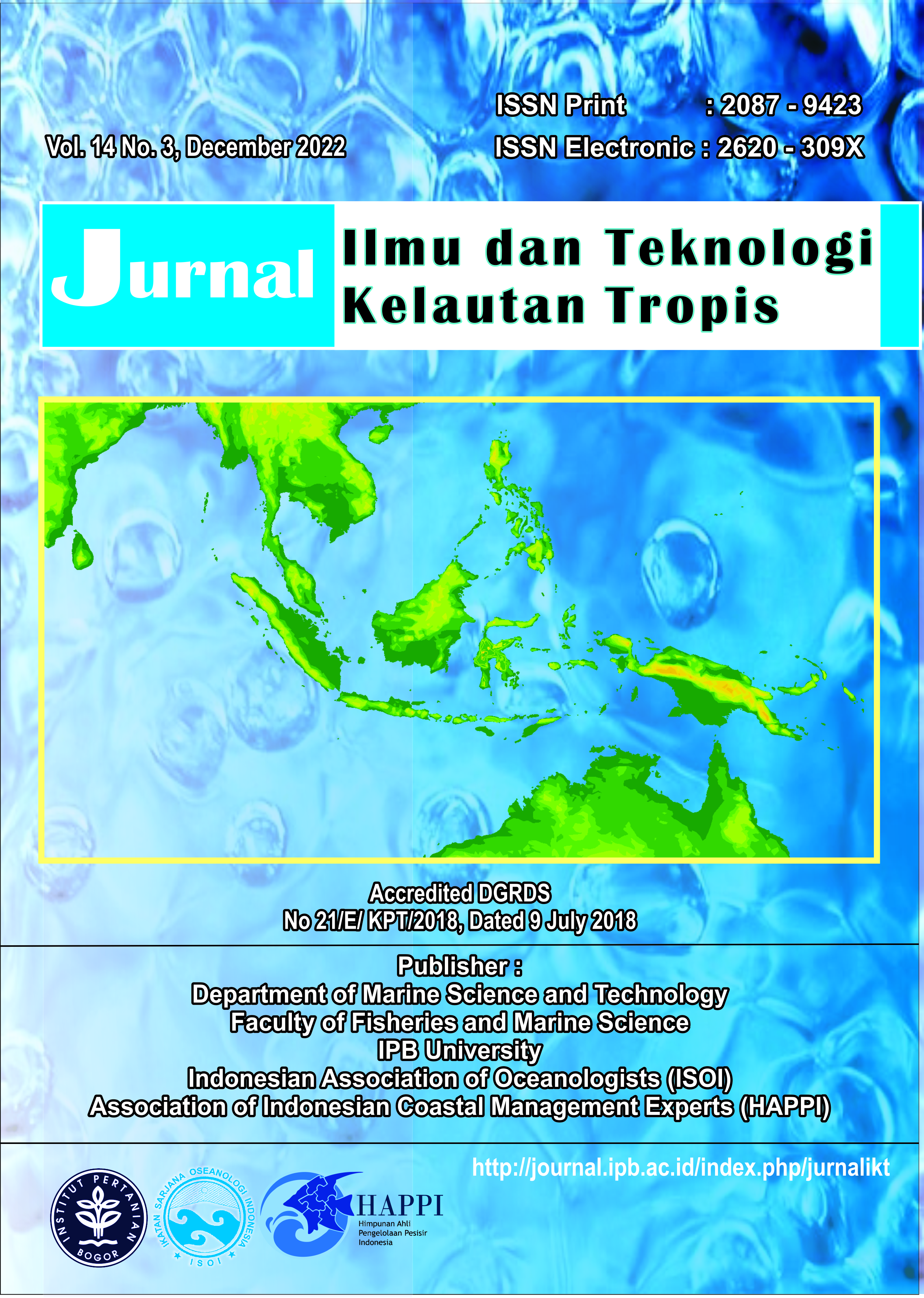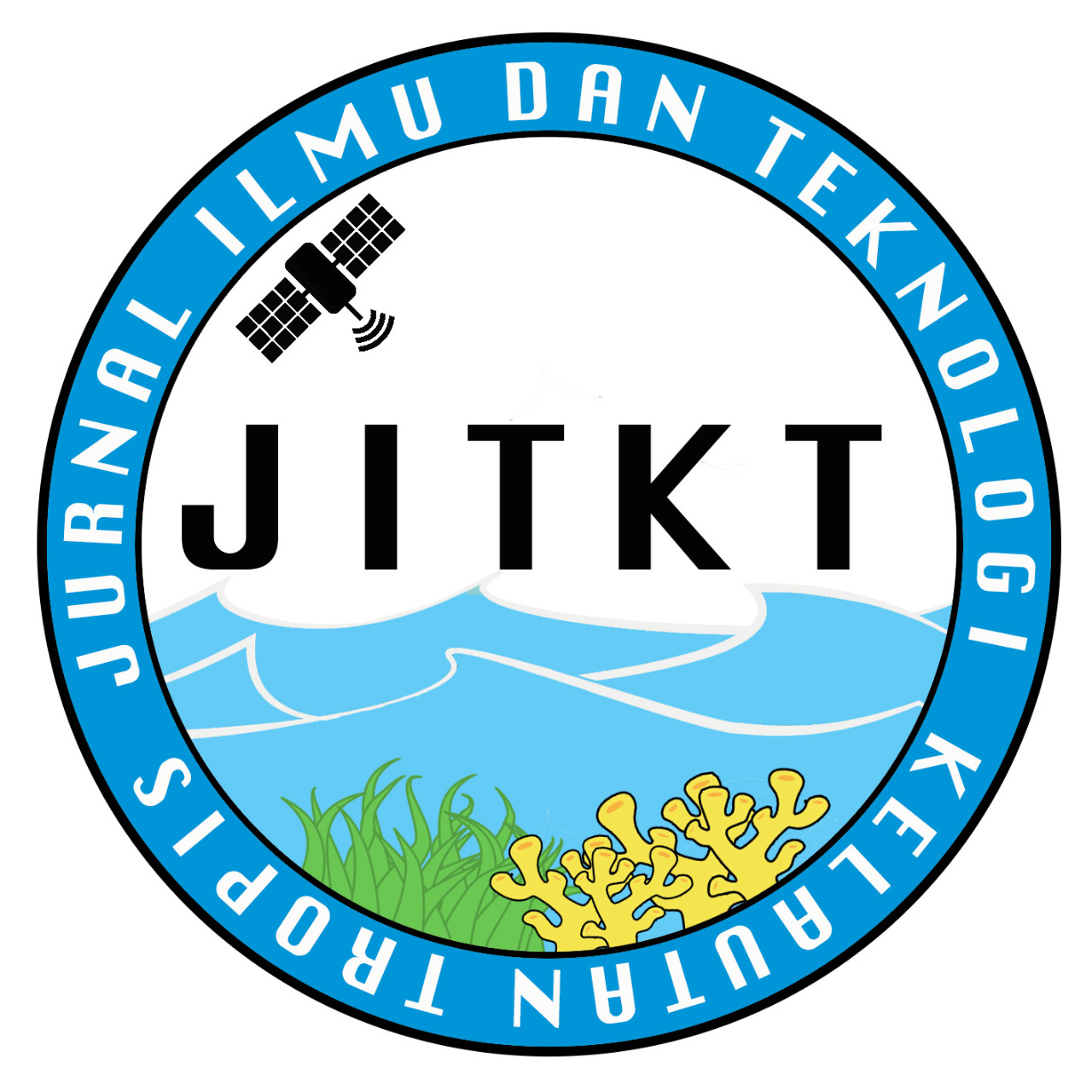MERCURY (Hg) CONCENTRATION IN SEDIMENT WATERS OF CIREBON, WEST JAVA DURING EAST TRANSITIONAL MONSOON
Abstract
Cirebon waters are one of the areas with dense fishing, industrial and human activities can cause heavy metal pollution in these waters. This study aims to analyze the Hg content in sediments and their relationship with environmental characteristics in three research sites on the Cirebon coast: i.e., Bondet, Sukalila, and Kejawanan. Nine research points were selected at each location. In situ analysis was carried out for temperature, salinity, pH, and DO variables. In addition, surface sediment samples were taken at variations in water depth between 1–6 m. Grain fraction, organic carbon, and heavy metal Hg were analyzed from each of the sediment samples. The results showed that the surface temperature, salinity, pH, and DO of Cirebon waters ranged from 31.09–32.30 oC; 26.4–30.10‰; 7.66–8.56; and 4.50–6.87 mg/L. Cirebon waters are dominated by silt and clay about 1% organic carbon. Mercury in sediments is still considered safe for aquatic life with a concentration of 29.36–68.55 µg/kg-dw. Principal Component Analysis shows that the three study sites have different water characteristics and hence, influence the Hg deposition. Overall, although Hg accumulation occurs, it is ecologically safe for biota life. Sedimentary accumulation of Hg was probably due to the terrestrial input and the condition of environmental deposition such as riverine flow and coastal current.
Downloads
References
Arifin, Z. 2008. Kajian Perubahan Ekologis Perairan Teluk Jakarta. Pusat Penelitian Oseanografi-LIPI. LIPI-Press. Jakarta. 211-228 pp.
Astjario, P. 2006. Penelitian lingkungan pantai wilayah pesisir Kabupaten Cirebon, Jawa Barat. JSDG, 16(1): 41-49. https://doi.org/10.33332/jgsm.geologi.v16i1.352
Australian and New Zealand Environment and Conservation Council & Agriculture and Resource Management Council of Australia and New Zealand (ANZECC–ARMCANZ). 2000. Australian and New Zealand Guidelines for Fresh and Marine Water Quality. Volume 1. ANZECC ARMCANZ. New South Wales. 314 p.
Azad, A.M., S. Frantzen, M.S. Bank, I.A. Johnsen, E. Tessier, D. Amouroux, L. Madsen, & A. Maage. 2019. Spatial distribution of mercury in seawater, sediment, and seafood from the Hardangerfjord ecosystem, Norway. Sci. Total Environ., 667: 622-637. https://doi.org/10.1016/j.scitotenv.2019.02.352
Badan Perencanaan Pembangunan Daerah Kota Cirebon (BPPD). 2015. Profil Kota Cirebon. Pemerintah Kota Cirebon. Cirebon. 24 p.
Badan Perencanaan Pembangunan, Penelitian dan Pengembangan Daerah (BPPPPD). 2009. Rencana Pembangunan Jangka Panjang Daerah (RPJPD) Kabupaten Cirebon Tahun 2005–2025. BPPPPD Kabupaten Cirebon. Cirebon. 105 p.
Batrakova, N., O. Travnikov, & O. Rozovskaya. 2014. Chemical and physical transformations of mercury in the ocean: a review. Ocean Sci., 10: 1047–1063. https://doi.org/10.5194/os-10-1047-2014
Bayhaqi, A. & C.M.A. Dungga. 2015. Distribusi butiran sedimen di Pantai Dalegan, Gresik, Jawa Timur. J. Depik, 4(3): 153–159. https://doi.org/10.13170/depik.4.3.3054
Benoit, J.M., C.C. Gilmour, A. Heyes, R.P. Mason, & C.L. Miller. 2003. Geochemical and biological controls over methylmercury production and degradation in aquatic system. in: Biochemistry of Environmentally Important Trace Elements. Yong C, Braids OC, editor. American Chemical Society. Washington. 262–297 pp.
Boszke, L., A. Kowalski, G. Closinska, R. Szarek, & J. Siepak. 2003. Environmental factors affecting speciation of mercury in the bottom sediments: an overview. Pol. J Environ. Stud., 12(1): 5–13. http://www.pjoes.com/Environmental-Factors-Affecting-the-Speciation-of-Mercury-in-the-Bottom-Sediments,87519,0,2.html
Braune, B., J. Chetelat, M. Amyot, T. Brown, M. Clayden, M. Evans, A. Fisk, A. Gaden, C. Girard, A. Hare, J. Kirk, I. Lehnherr, R. Letcher, L. Loseto, R. Macdonald, E. Mann, B. McMeans, D. Muir, N. O’Driscoll, A. Poulain, K. Reimer, & G. Stern. 2015. Mercury in the marine environment of the Canadian Artic: review of recent findings. Sci Total Environ, 509–510: 67–90. https://doi.org/10.1016/j.scitotenv.2014.05.133
Budiyanto, F. & Lestari. 2014. Distribution of metals in Cisanggarung Estuary sediment, West Java, Indonesia. Mar. Res. Indonesia, 39(1): 23-30. https://doi.org/10.14203/mri.v39il.90
Burone, L., P. Muniz, M.S. Pires–Vanin, & Rodrigues. 2003. Spatial distribution of organic matter in the surface sediments of Ubatuba Bay (Southeastern–Brazil). An Acad Bras Cienc, 75(1): 77–90. https://doi.org/10.1590/S0001-37652003000100009
Canadian Council of Ministers of the Environment (CCME). 2001. Canadian Sediment Quality Guidelines for the Protection of Aquatic Life. CCME. Winnipeg. 1-5 pp.
Chester, R. & T. Jickells. 2012. Marine Geochemistry. Third Edition. London (UK): Willey-Blackwell. 438 p.
Darmono. 2001. Lingkungan Hidup dan Pencemaran: Hubungan Dengan Toksikologi Senyawa Logam. UI Press. Depok. 140 p.
DelVecchia, A.G., J.F. Bruno, L. Benninger, M. Alperin, O. Banerjee, & J.D. Morales. 2014. Organic carbon inventories in natural and resort Ecuadorian mangrove forests. Peer J, 2: 1–18. https://doi.org/10.7717/peerj.388
Driscoll, C.T., R.P. Mason, H.M. Chan, D.J. Jacob, & N. Pirrone. 2013. Mercury as a global pollutant: sources, pathways, and effects. Environ. Sci. Technol., 47: 4967–4983. https://doi.org/10.1021/es305071v
Dyer, K.R. 1986. Coastal and Estuarine Sediment Dynamics. John Wiley and Sons. Chichester. 342 p.
Edward. 2008. Pengamatan kadar merkuri di Teluk Kao dan perairan Anggai Maluku Utara. Makara Sains, 12: 97-101. https://doi/org/10.7454/mss.v12i2.500
Flemming, B.W. 2011. Geology, morphology, and sedimentology of estuaries and coasts. Di dalam: Wolanski E. & McLusky D.S., (eds). Treatise on Estuarine and Coastal Science. Volume ke–3. Academic Pr. Waltham. 7–38 pp.
Gworek, J., O. Bemowska-Kalabun, M. Kijenska, & J. Wrosek-Jakubowska. 2016. Mercury in marine and oceanic waters-a review. Water Air Sil. Pollut., 227: 371. https://doi.org/10.1007/s11270-16-3060-3
Hajeb, P., S. Jinap, A. Ismail, A.B. Fatimah, B. Jamilah, & M.A. Rahim. 2009. Assessment of mercury level in commonly consumed marine fishes in Malaysia. Food Control, 20(1): 79–84. https://doi.org/10.1016/j.foodcont.2008.02.012
Hatje, V., T.E. Payne, D.M. Hill, G. McOrist, G.F. Birch, & R. Szymczak. 2003. Kinetics of trace element uptake and release by particles in estuarine waters: effects of pH, salinity, and particle loading. Environ Int., 29(5): 619-629. https://doi.org/10.1016/S0160-4120(03)00049-7
Hosseini, S.M., N. Mirghaffari, N. Mahboobi–Soofiani, & L. Khodakarami. 2011. Evaluation of mercury contamination in the Caspian Sea’s sediment by GIS and geostatistic. Iranian J. of Natural Resources, 64(2): 169–183. https://www.sid.ir/en/Journal/ViewPaper.aspx?ID=219234
Howard, J, S. Hoyt, K. Isensee, E. Pidgeon, & M. Telszewski. 2014. Coastal Blue Carbon: Methods for Assessing Carbon Stocks and Emissions Factors in Mangroves, Tidal Salt Marshes, and Seagrass Meadows. Conservation International, Intergovernmental Oceanographic Commission of UNESCO, International Union for Conservation of Nature. Arlington Virginia. 180 p.
Hsieh, H.L. 1995. Spatial and temporal patterns of polychaete communities in a subtropical mangrove swamp: influences of sediment and microhabitat. Mar. Ecol. Prog. Ser., 127: 157-167. https://doi.org/10.3354/meps127157
Hubbard, J.E.B. & Y. Pocock. 1972. Sediment rejection by recent scleractinian corals: a key to palaeo–environmental. Geol Rundsch, 61(2): 598–626. https://doi.org/10.1007/BF01896337
Ismail, M.F.A. 2014. Dinamika batimetri alur pelayaran Pelabuhan Cirebon Provinsi Jawa Barat. J. Depik, 3(1): 74-82. https://doi.org/10.13170/depik.3.1.1356
Leksono, A, W. Atmodjo, & L. Maslukah. 2013. Studi arus laut musim barat di perairan Pantai Kota Cirebon. J-Oce, 2(3): 206-213. https://ejournal3.undip.ac.id/index.php/joce/article/view/4554
Lestari, & F. Budiyanto. 2013. Konsentrasi Hg, Cd, Cu, Pb, dan Zn dalam sedimen di Perairan Gresik. J. Ilmu dan Teknologi Kelautan Tropis, 5(1): 182-291. https://doi.org/10.29244/jitkt.v5i1.7764
Lestari & F. Budiyanto. 2016. Konsentrasi logam berat dalam sedimen di Perairan Lombok Barat. Di dalam: Kualitas Lingkungan untuk Menunjang Budi Daya Biota Laut di Perairan Lombok Barat. Puspitasari R. & Natsir S. M. (eds). LIPI Pr. Jakarta. 81–96 pp.
Liu, G., Y. Li, & Y. Cai. 2012. Adsorption of mercury on solids in the aquatic environment. Di dalam: Environment Chemistry and toxicology of Mercury. Edisi ke–1. Liu G., Cai Y., & O’Driscoll N. (eds). John Wiley and Sons Inc. Chichester. 367–387 pp.
Luthfillah, K. 2011. Kasus Newmont: pencemaran di Teluk Buyat. J. Kybernan, 2(1): 17-19. http://jurnal.unismabekasi.ac.id/index.php/kybernan/article/view/662
Marchio, D.A., M. Savarese, B. Bovard, & W.J. Mitsch. 2016. Carbon sequestration and sedimentation in mangrove swamps influenced by hydrogeomorphic conditions and urbanization in Southwest Florida. Forests, 7(6): 116. https://doi.org/10.3390/f7060116
Minamata Disease Municipal Museum. 2007. Minamata Disease: Its History and Lessons. Minamata City Planning Division. Minamata. 20 p.
Muto, E.Y., L.S.H. Soares, J.E.S. Sarkis, M.A. Hortellani, M.V. Petti, & T.N. Corbisier. 2014. Biomagnification of mercury through the food web of the Santos continental shelf, subtropical Brazil. Mar Ecol Prog Ser, 512: 55–69. https://doi.org/10.3354/meps10892
National Oceanic and Atmospheric Administration (NOAA). 1999. Screening Quick Quality Guidelines Developed for the National Status and Trends Program. NOAA. Washington. 1-12 pp.
National Oceanic and Atmospheric Administration (NOAA). 2004. Screening Quick Reference Tables: Hazmat Reports. NOAA. Washington. 1-12 pp.
Neopane, H.P. & S. Surandra. 2013. Particle size distribution and mineral analysis of sediments in Nepalese hydropower plant: a case study of Jhimruk hydropower plant. Kathmandu University J. of Science, Engineering and Technology, 9(1): 29–36. http://old.ku.edu.np/kuset/index.php?go=vol14_no2
Nippon Instruments Corporation (NIC). 2015. Fully-automatic Thermal Vaporization Mercury Analysis Sistem Mercury/MA-3000 Instruction Manual. NIC. Osaka. 104 p.
Nugroho, S.H. & A. Basit. 2014. Sebaran sedimen berdasarkan analisis ukuran butir di Teluk Weda, Maluku Utara. J. Ilmu dan Teknologi Kelautan Tropis, 6(1): 229–240. http://journal.ipb.ac.id/index.php/jurnalikt/article/view/8644/6763
Nurhayati, D. & D.A. Putri. 2018. Bioakumulasi logam berat merkuri (Hg) di musim hujan pada budidaya kerang hijau (Perna viridis) di Perairan Cirebon, Jawa Barat. J. of Aquaculture Science, 3(1): 38-45. https://doi.org/10.31093/joas.v3i1.39
Paundanan, M., E. Riani, & S. Anwar. 2015. Kontaminasi logam berat merkuri (Hg) dan Timbal (Pb) pada air, sedimen dan ikan selar tetengkek (Megalaspis cordyla L) di Teluk Palu, Sulawesi Tengah. J. Pengelolaan Sumberdaya Alam dan Lingkungan, 5(2): 161-168. https://doi.org/10.29244/jpsl.5.2.161
Pirrone, N., S. Cinnirella, X. Feng, R.B. Finkelman, H.R. Friedli, J. Leaner, R. Mason, A.B. Mukherjee, G.B. Stracher, D.G. Streets, & K. Telmer. 2010. Global mercury emission to the atmosphere from anthropogenic and natural sources. Atoms Chem. Phys., 10: 5951–5964. https://doi.org/10.5194/acp-10-5951-2010
Poerbandono & Djunarsjah, E. 2005. Survey Hidrografi. Herlina R. (ed). Refika Aditama. Bandung. 133-136 pp.
Purnawan, S., R. Sikanna, & Prismawiryanti. 2013. Distribusi logam merkuri pada sedimen laut di sekitar muara Sungai Poboyo. J. of Natural Science, 2(1): 18-24. https://bestjournal.untad.ac.id/index.php/ejurnalfmipa/article/view/1580
Purnawan, S., A. Haridhi, I. Setiawan, & Marwantim. 2015. Parameter statistik ukuran butir pada sedimen berpasir Muara Kuala Gigeng, Kabupaten Aceh Besar. J. Ilmu dan Teknologi Kelautan Tropis, 7(1): 15–21. https://doi.org/10.29244/jitkt.v7i1.9739
Puspitasari, R. 2011. Aspek toksisitas sedimen pesisir Cirebon terhadap abnormalitas larva kerang hijau, Perna viridis. J. Oseanologi dan Limnologi di Indonesia, 37(2): 235-245. http://lipi.go.id/publikasi/aspek-toksisitas-sedimen-pesisir-cirebon-terhadap-abnormalitas-larva-kerang-hijau-perna-viridis/23073
Putra, P.S. & S.H. Nugroho. 2017. Distribusi sedimen permukaan dasar laut Perairan Sumba, Nusa Tenggara Timur. J. Oseanologi dan Limnologi di Indonesia, 2(3): 49–63. https://doi.org/10.14203/oldi.2017.v2i3.118
Rzasa, S. & W. Owczarzak. 2013. Methods for the granulometric analysis of soil for science and practice. Pol. J. Soil. Sci., 46(1): 1–50. https://doi.org/10.17951/pjss.2013.46.1.1
Riley, J.P. & R. Chester. 1976. Chemical Oceanography. Edisi ke-2. Academic Press Inc. London. 414 p.
Samman, A. 2014. Konsentrasi merkuri dan hubungannya dengan indeks kepadatan keong popaco (Telescopium Telescopium) di Kao Teluk, Halmahera Utara. J. DEPIK, 3(2): 128–136. https://doi.org/10.13170/depik.3.2.1471
Sanusi, H.S. 2006. Kimia Laut dan Pencemaran: Proses Fisik Kimia dan Interaksinya dengan Lingkungan. Departemen Ilmu dan Teknologi Kelautan IPB. Bogor. 188 p.
Sherman, D.J., L. Davis, & S.L. Namikas. 2013. Sediments and Sediment Transport. Di dalam: John FS, editor. Treats on Geomorphology. Volume 1. San Diego (US): Academic Pr. 233-256 pp.
Schumacher, B.A. 2002. Methods for The Determination of Total Organic Carbon (TOC) in Soils and Sediments. Ecological Risk Assessment Support Center Office of Research and Development. Cincinnati (US): Environmental Protection Agency. 23 p.
Simpson, S.L, G.B. Batley, & A.A. Chariton. 2013. Revision of ANZECC/ARMCANZ Sediment Quality Guidelines. CSIRO Land and Water Science report 08/07. Canberra (AU): CSIRO Land and Water. 132 p.
Sudirman N. & S. Husrin. 2014. Status baku mutu air laut untuk kehidupan biota dan indeks pencemaran perairan di Pesisir Cirebon pada musim kemarau. J. Ilmiah Perikanan dan Kelautan, 6(2): 149-154. https://doi.org/10.20473/jipk.v6i2.11300
Suratman, S., N.H.C. Zan, A.B. Aziz, & N.M. Tahir. 2017. Spatial and seasonal variations of organic carbon–base nutrients in Setiu Wetland, Malaysia. Sains Malays., 16(6): 859–865. https://doi.org/10.17576/jsm-2017-4606-04
Triharto, W. 2018. Reklamasi pesisir Kota Cirebon. F. Exac, 11(4): 385–398. https://doi.org/10.30998/faktorexacta.v11i4.2838
Venkatramanan, S., T. Ramkumar, I. Anithamary, & G. Ramesh. 2011. Variations in texture of beach sediments in the vicinity of the Tirumalairajanar river mouth of India. International J. of Sediment Research, 26(4): 460–470. https://doi.org/10.1016/S1001-6279(12)60005-5
Wachecka–Kotkowska, L. & P. Kotkowski. 2011. Grain-size distribution analysis of quaternary sediments from the southern part of the Lodz region in Poland: a computational methods approach. Geologos, 17(4): 205-219. https://doi.org/10.2478/v10118-011-0012–7
Wentworth, C.K. 1922. A scale of grade and class terms for clastic sediments. J. Geo., 30(5): 377–390. https://www.jstor.org/stable/30063207
Ziyaadini, M., Z. Yousefiyanpour, J. Ghasemzadeh, & M.M. Zahedi. 2017. Biota-sediment accumulation factor and concentration of heavy metals (Hg, Cd, As, Ni, Pb and Cu) in sediments and tissue of Chiton lamyi (Mollusca: Polyplacophora: Chitonidae) in Chabahar Bay, Iran. Iran J., 16(4): 1123-1134. http://jifro.ir/article-1-2952-en.html
Zhou, J., Z. Wang, & X. Zhang. 2018. Deposition and fate mercury in litterfall, litter, and soil in coniferous and broad-leaved forest. J. Geophys. Res. Biogeosci., 123(8): 2590-2603. https://doi.org/10.1029/2018JG004415
Copyright (c) 2022 Jurnal Ilmu dan Teknologi Kelautan Tropis

This work is licensed under a Creative Commons Attribution-ShareAlike 4.0 International License.
The author submitting the manuscript must understand and agree that the copyright of the article manuscript must be submitted/transferred to the Jurnal Ilmu dan Teknologi Kelautan Tropis. This work is licensed under the Creative Commons Attribution-ShareAlike 4.0 (CC BY-SA) International License in which the Author and Reader can copy and redistribute the material in any media or format, and remix, modify and build material for any purpose, but they must provide appropriate credit (citing articles or content), provide a link to the license, and indicate whether there is a change. If you mix, change, or create material, you must distribute your contribution under the same license as the original.



.png)














